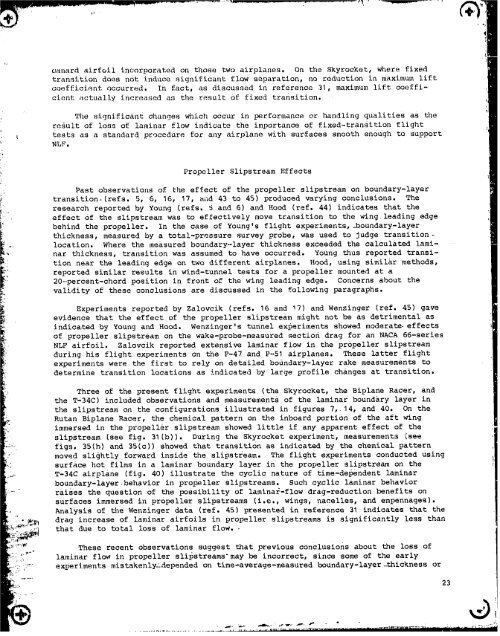NASA Technical Paper 2256 - CAFE Foundation
NASA Technical Paper 2256 - CAFE Foundation
NASA Technical Paper 2256 - CAFE Foundation
You also want an ePaper? Increase the reach of your titles
YUMPU automatically turns print PDFs into web optimized ePapers that Google loves.
canard airfoil incorporated on those two airplanes. On the Skyrocket, where fixed<br />
transition does not induce significant flow separation, no reduction in maximum lift<br />
coeffielent occurred. In fact, as discussed in reference 31t maximum lift coeffi-<br />
cient actually increased as the result Of fixed transition.<br />
The significant changes which occur in performance or handling qualities as the<br />
result of loss of laminar flow indicate the importance of fixed-transitfon flight<br />
tests as a standard procedure for any airplane with surfaces smooth enough to support<br />
NLF.<br />
Propeller Slipstream Effects<br />
Past observations of the effect of the propeller slipstream on boundary-layer<br />
transition-(refs. 5, 6, 16, 17, and 43 to 45) produced varying conclusions. The<br />
research reported by Young (refs. 5 and 6) and Hood (ref. 44) indicates that the<br />
effect Of the slipstream was to effectively move transition to the wing leading edge<br />
behind the propeller. In the case of Young's flight experiments,_boundary-layer<br />
thickness, measured by a total-pressure survey probe, was used to judge transition-<br />
location. Where the measured boundary-layer thickness exceeded the calculated lami-<br />
nar thickness, transition was assumed to have occurred. Young thus reported transi-<br />
tion near the leading edge on two different airplanes. Hood, using similir methods,<br />
reported similar results in wind-tunnel tests for a propeller mounted at a<br />
20-percent-chord position in front of the wing leading edge. Concerns about the<br />
validity of these conclusions are discussed in the following paragraphs.<br />
Experiments reported by Zalovcik (refs. 16 and _7) and Wenzinger (ref. 45) gave<br />
evidence that the effect of the propeller slipstream might not be as detrimental as<br />
indicated by Young and Hood. Wenzinger's tunnel experiments showed moderate-effects<br />
of propeller slipstream on the wake-probe-measured section drag for an NACA 66-series<br />
NLF airfoil. Zalovcik reported extensive laminar flow in the propeller slipstream<br />
during his flight experiments on the P-47 and P-51 airplanes. These latter flight<br />
experiments were the first to reiM on detailed boundary-layer rake measurements to<br />
determine transition locations as indicated by large profile changes at transition.<br />
Three of the present flight experiments (the Skyrocket, the Biplane Racer, and<br />
the T-34C) included observations and measurements of the laminar boundary layer in<br />
the slipstream on the configurations illustrated in figures 7, 14, and 40. On the<br />
Rutan Biplane Racer, the chemical pattern on the inboard portion of the aft wing<br />
immersed in the propeller slipstream showed little if any apparent effect of the<br />
slipstream (see fig. 31(b)). During the Skyrocket experiment, measurements

















